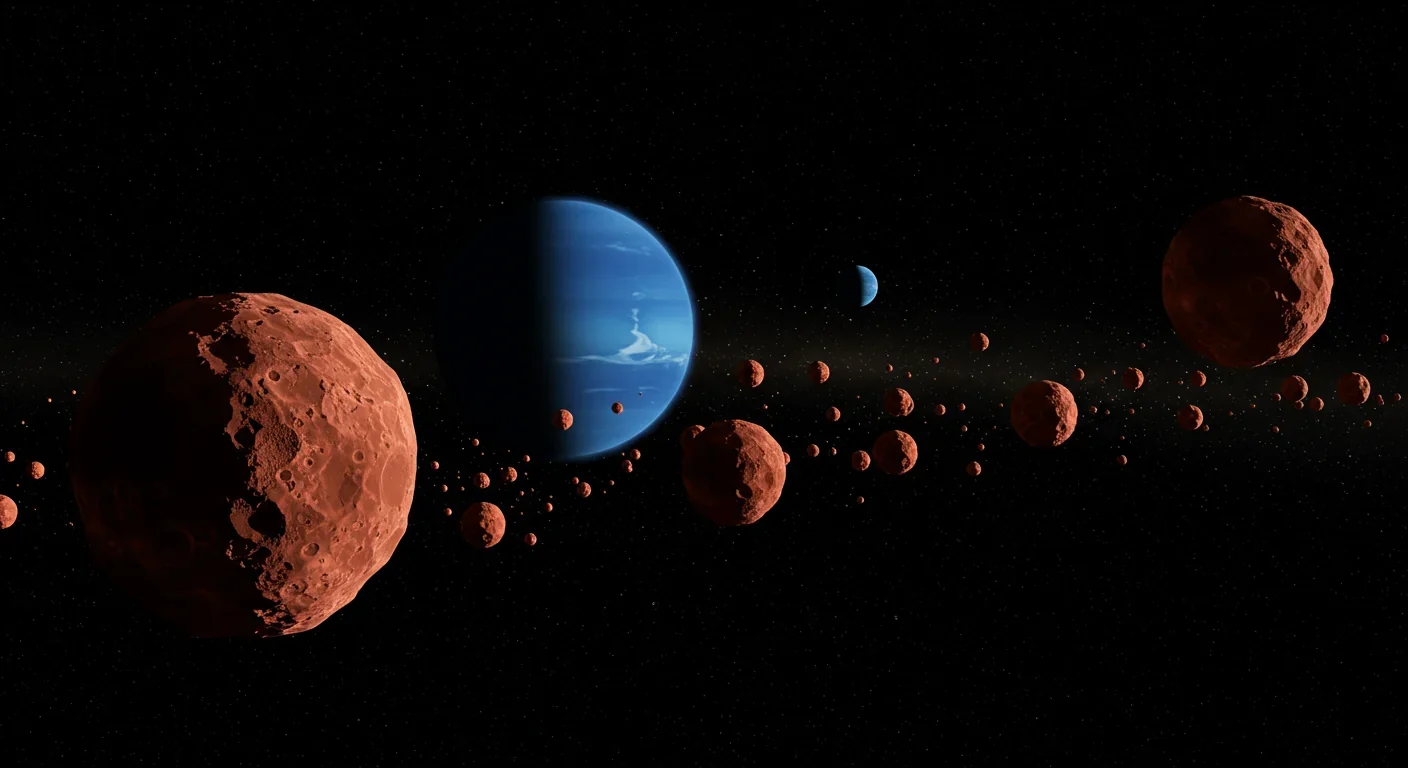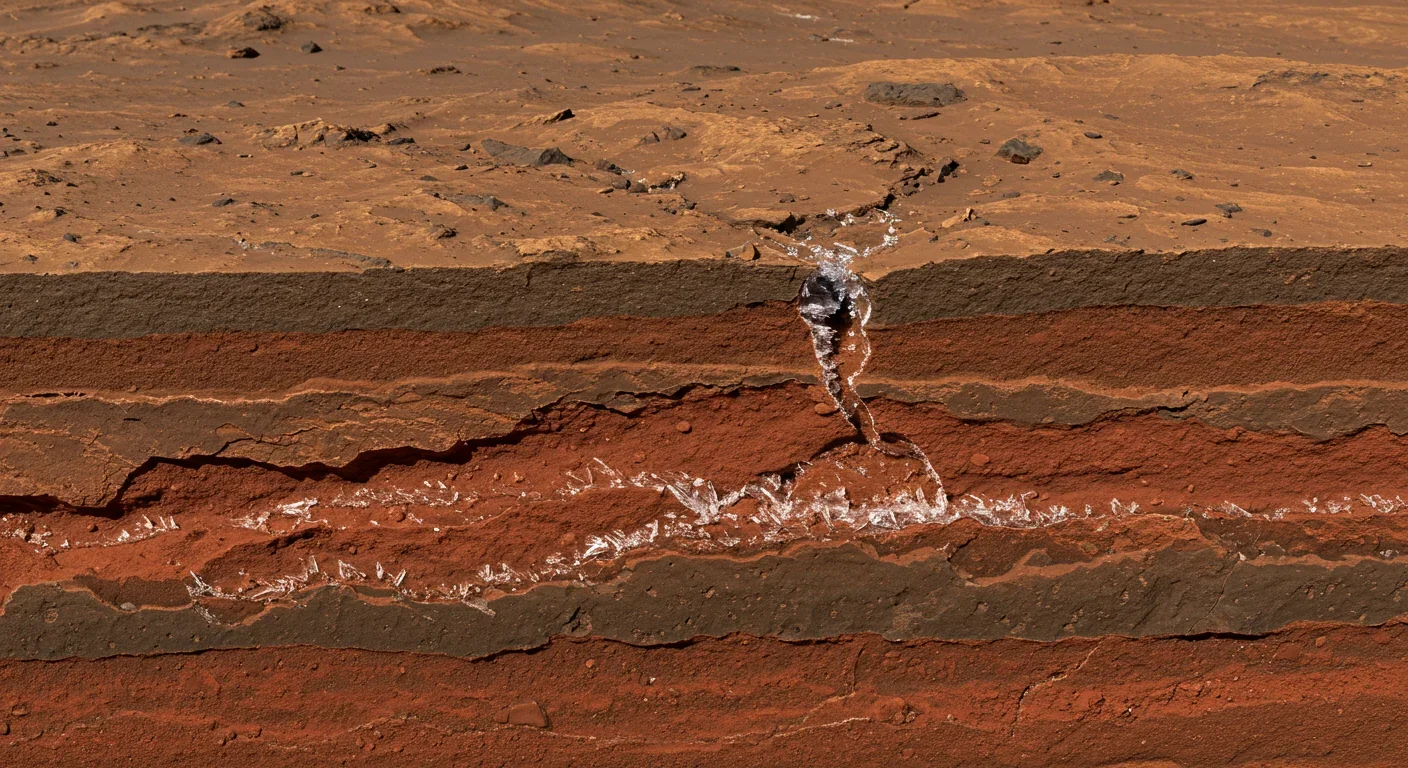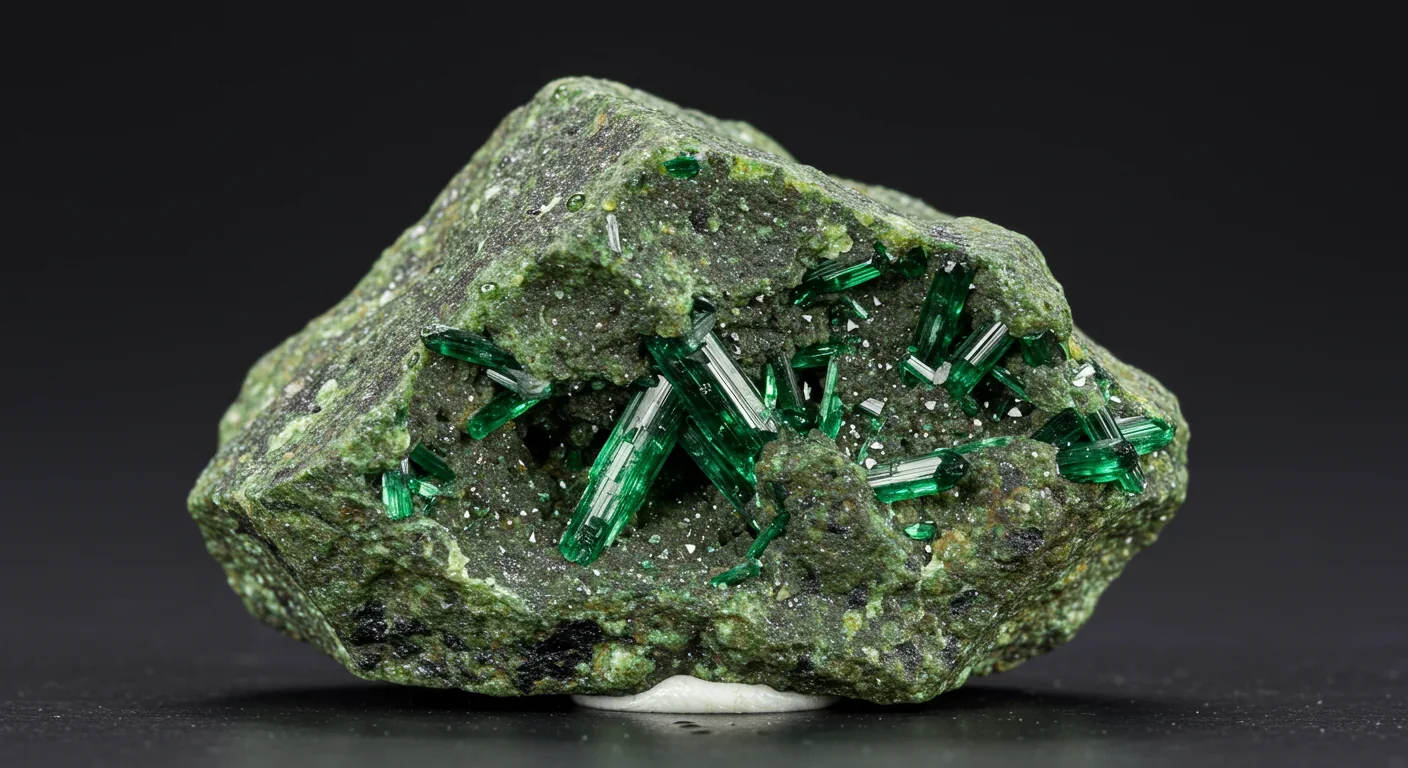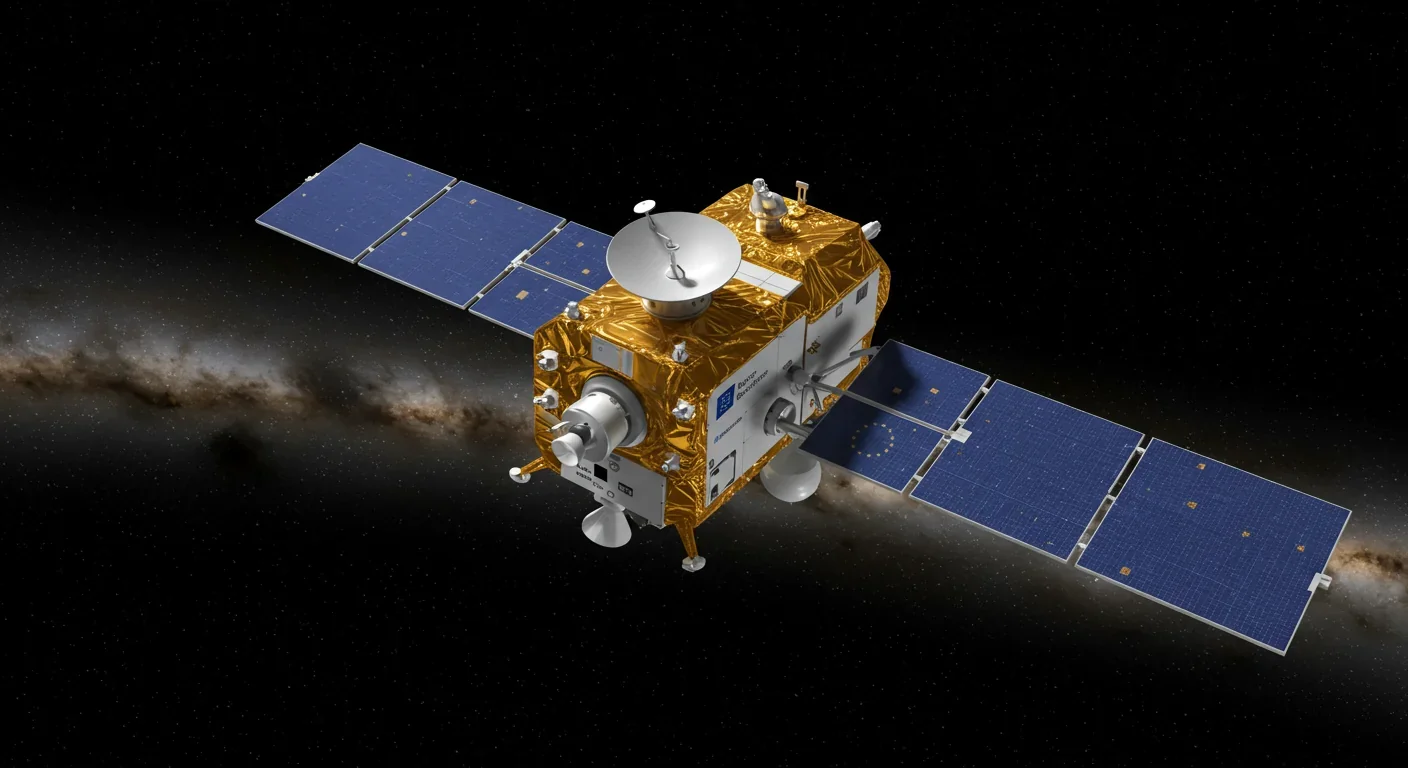Frozen Archive: Kuiper Belt Rewrites Solar System Origins

TL;DR: Curiosity rover detects mysterious methane spikes on Mars that vanish within hours, defying atmospheric models. Scientists debate whether the source is hidden microbial life or geological processes, while new research reveals UV-activated dust rapidly destroys the gas.
Curiosity didn't expect to find ghosts. Yet for over a decade, the rover has tracked something that appears and vanishes on Mars like a phantom—methane gas that spikes to detectable levels, then disappears within hours. On Earth, 90% of atmospheric methane comes from living organisms. On Mars, the implications could reshape humanity's understanding of life in the universe.
Since landing at Gale Crater in 2012, NASA's Curiosity rover has measured methane concentrations ranging from barely detectable traces below 0.2 parts per billion to sudden spikes exceeding 20 parts per billion. The pattern is maddeningly inconsistent—background levels hover around 0.4 ppb, then surge during specific seasons, only to crash back to baseline. One spike in late 2013 reached 7 ppb and persisted for weeks before evaporating. The second Martian year? Nothing. No repeat performance, no explanation.
Meanwhile, orbiting 400 kilometers above, the European Space Agency's Trace Gas Orbiter sees essentially nothing. Its sensitive spectrometers, scanning the middle and upper atmosphere, detect no methane above their threshold of 0.02 ppb. The methane Curiosity measures at ground level somehow fails to reach orbital altitudes, or it's destroyed so rapidly that it never gets the chance.
Welcome to the most perplexing atmospheric mystery in planetary science—one that could either announce the discovery of alien life or reveal how little we understand about Mars' chemistry.

Methane is chemistry's rebel molecule. Four hydrogen atoms bonded to a carbon core, it's simultaneously abundant and unstable, easily created yet quickly destroyed. On Earth, you'll find it bubbling from wetlands where bacteria feast in oxygen-free muck, belching from cattle digesting grass, seeping from deep-sea thermal vents where microbes colonize the most hostile environments imaginable. Biology loves making methane because it's energetically cheap—the waste product of ancient metabolic pathways that evolved when Earth's atmosphere lacked oxygen.
That's why detecting methane on Mars matters so profoundly. The Red Planet is cold, dry, bathed in ultraviolet radiation, and possesses an atmosphere 100 times thinner than Earth's. Any methane released into this environment should persist for centuries according to standard photochemical models—UV radiation slowly dismantles the molecule over hundreds of years. Instead, Curiosity's measurements show methane appearing and vanishing on timescales of days to weeks.
The data paints a picture of extreme spatial and temporal variability. Five years of continuous monitoring revealed background levels fluctuating seasonally from 0.24 ppb in southern-hemisphere autumn to 0.65 ppb at other times—a nearly threefold variation. Transient spikes jump even higher, sometimes exceeding 20 ppb in localized plumes. These aren't measurement errors; Curiosity's Tunable Laser Spectrometer has confirmed the pattern across multiple Martian years.
So something on Mars produces methane in bursts, then something else destroys it at rates 600 times faster than photochemistry alone can explain. The question driving astrobiologists and geochemists to friendly arguments across conference halls: is that something alive?
If microbes exist on Mars, they're probably methanogens—hardy, oxygen-hating archaea that produce methane as metabolic exhaust. On Earth, these organisms thrive in places that would kill most life: kilometers-deep crystalline rock fractures where no sunlight penetrates, Antarctic lakes buried under ice sheets, hypersaline ocean basins devoid of oxygen. They don't need much—just liquid water, hydrogen gas, carbon dioxide, and temperatures above freezing.
Mars might secretly offer those conditions. While the surface is a frozen desert, recent modeling suggests the subsurface could harbor surprisingly habitable pockets. A November 2024 study in Astrobiology identified Acidalia Planitia, a vast northern plain, as the most promising candidate. Combining data on buried water-ice distribution, radiogenic heat production from thorium, uranium, and potassium in Martian regolith, and thermal modeling of the planet's crust, researchers pinpointed a potential methanogen habitat between 4.3 and 8.8 kilometers deep.

At those depths, temperatures could reach 20 to 40 degrees Celsius—comfortably warm by microbial standards. Tiny fractures in rock might channel liquid water, kept from freezing by subsurface pressure and geothermal heating. If methanogens analogous to Earth's Methanosarcinaceae and Methanomicrobiaceae families colonized such environments billions of years ago when Mars was wetter, they could persist today, isolated in deep aquifers.
The seasonal pattern fits this scenario surprisingly well. As Martian temperatures shift with the planet's eccentric orbit and axial tilt, subsurface ice could intermittently melt, briefly activating dormant microbial communities. They'd metabolize, produce methane, then go dormant when conditions deteriorate—explaining why spikes are episodic rather than constant. The methane would then migrate upward through porous regolith, eventually seeping into the atmosphere at localized surface vents.
But here's where biology faces its toughest challenge: proving a negative is impossible. Every biological explanation must compete with geological alternatives that don't require invoking Martian life.
The atmospheric lifetime of methane on Mars should be several centuries based on photochemistry. Observed disappearance in days requires destruction rates 600 times faster than models predict.
Mars is geologically restless in ways we've only begun to appreciate. While it lacks Earth-style plate tectonics, the planet shows evidence of recent volcanism, subsurface ice movement, and ongoing seismic activity detected by NASA's InSight lander. Each process offers plausible routes to methane production without involving biology.
Serpentinization—the chemical reaction of water with olivine-rich rocks—tops the list. When liquid water percolates through ultramafic minerals in the presence of carbon dioxide, it generates hydrogen gas and, under the right conditions, methane. This process operates in Earth's deep-sea hydrothermal systems and has been confirmed in laboratory experiments simulating Martian subsurface chemistry. Mars possesses abundant olivine exposed at the surface and likely throughout its crust. If subsurface aquifers exist, serpentinization could steadily produce methane over geological timescales.
Another possibility involves ancient methane trapped in clathrate hydrates—ice-like cages that lock gas molecules inside crystalline water structures. Early Mars, wetter and warmer, might have formed extensive clathrate deposits. As the climate shifted and the planet dried out, these frozen methane reservoirs became buried. Seasonal temperature variations, impacts from meteorites, or tectonic stress could periodically crack open clathrate deposits, releasing methane pulses into the atmosphere.

Then there's the exotic option: electrical discharge during dust storms. Mars experiences planet-wide dust storms that generate massive static electricity. When charged dust particles collide in the presence of water ice and carbon dioxide, laboratory experiments show they can synthesize small amounts of organic molecules, including methane. While yields are low, Mars' frequent dust devil activity and seasonal global dust storms could contribute to background methane levels.
Geophysical mechanisms explain episodic release, but they struggle with the rapid destruction problem. If geological processes produce methane continuously or in seasonal bursts, why doesn't it accumulate in the atmosphere over centuries? That question leads to the third piece of the puzzle.
For years, scientists couldn't reconcile the rover-orbiter discrepancy. Curiosity smells methane at ground level; the Trace Gas Orbiter detects nothing from space. Either the measurements are wrong (unlikely—both instruments work precisely), methane exists only in a thin near-surface layer, or something destroys it before it reaches higher altitudes.
In 2022, a team led by researchers at UCLA proposed a solution: UV-activated perchlorate dust. Mars' surface is rich in perchlorates—highly reactive chlorine compounds that absorb ultraviolet radiation. When sunlight hits perchlorate-laden dust particles suspended in the lower atmosphere, it activates chemical reactions that rapidly adsorb and destroy methane molecules. Laboratory experiments showed this mechanism operates on timescales of hours to days—exactly matching the observed disappearance rates.
The implications are profound. Methane released at night, when UV radiation is absent, could accumulate in Gale Crater's calm nighttime air, explaining Curiosity's detections. At dawn, as sunlight illuminates the crater, perchlorate dust begins destroying methane faster than it can diffuse upward. By the time afternoon arrives, concentrations drop below detection limits. Higher in the atmosphere, continuous UV exposure ensures methane never accumulates enough for the Trace Gas Orbiter to see.
When researchers incorporated this destruction mechanism into vertical diffusion models of Mars' atmosphere, the results matched observations beautifully. The discrepancy between surface and orbital measurements wasn't a contradiction—it was evidence of a previously unknown chemistry unique to Mars' oxidizing environment.

This finding doesn't eliminate biological or geological sources. It just adds another variable: Mars apparently possesses a self-cleaning atmosphere that scrubs methane far more efficiently than Earth's. Whatever produces the gas must do so rapidly or in concentrated bursts to overcome this relentless destruction.
"The intense debate about the presence of methane in the Martian atmosphere has stimulated the study of methanogens adapted to terrestrial habitats that mimic Martian environments."
— Spanish research team, Astrobiology journal
The methane detection saga is also a story about the limits of remote sensing. Every instrument sees Mars through a different lens, and those perspectives sometimes clash in revealing ways.
Ground-based telescopes on Earth initially reported methane detections in the early 2000s, sparking excitement about potential Martian biology. Follow-up observations couldn't replicate the findings. The problem? Telluric contamination—Earth's own methane-rich atmosphere interferes with spectroscopic measurements of Mars, making it nearly impossible to reliably detect low concentrations from the ground.
Mars Express, Europe's first orbiter to arrive in 2003, reported methane detections in 2004 using its Planetary Fourier Spectrometer. Concentrations varied regionally and temporally, with localized plumes reaching 60 parts per billion. But the instrument's sensitivity was marginal, and atmospheric scientists questioned whether the signal was real or instrumental noise.
Then came Curiosity with its highly sensitive Tunable Laser Spectrometer, sitting directly on Mars' surface and sampling atmosphere just centimeters from the regolith. Its measurements established beyond doubt that methane exists at Gale Crater, at least episodically. But surface measurements sample only a tiny volume—what happens at one location might not reflect global or even regional conditions.
The Trace Gas Orbiter launched specifically to resolve the controversy. Its two complementary spectrometers—NOMAD and ACS—were designed to detect methane down to parts per trillion. The orbiter surveys the entire planet, sampling the atmosphere from 5 kilometers altitude upward. Finding essentially no methane was shocking. Either Mars Express data was spurious, Curiosity is detecting something localized and transient, or methane is confined to the lowest atmospheric layer.
Recent analyses suggest the third option is correct. Methane on Mars appears to be a boundary-layer phenomenon—concentrated near the surface where it's produced or released, then destroyed before rising high enough for orbiters to detect. This reconciles the data but also means that finding methane sources requires surface missions or very low-altitude observations, not orbital surveys.
There's one more uncomfortable possibility that emerged in 2025. A review of Curiosity's instrument suggested potential contamination from terrestrial methane leaking within the Tunable Laser Spectrometer's foreoptics chamber. If true, some or all of Curiosity's detections might be artifacts—Earth methane trapped in the rover's instrument, not Martian methane from the atmosphere. NASA engineers are investigating, but the possibility casts a shadow over 13 years of data.

Strip away speculation and focus on verified observations, and the picture looks like this:
Curiosity has repeatedly measured methane concentrations at Gale Crater averaging 0.41 ppb, with seasonal variations between 0.24 and 0.65 ppb, and occasional spikes reaching 7 to potentially 20+ ppb. These measurements span multiple Martian years and show repeatable seasonal patterns.
The Trace Gas Orbiter has surveyed Mars globally from orbit and found methane concentrations below its detection threshold of 0.02 ppb in the middle and upper atmosphere. This doesn't mean methane isn't present—only that if it exists, it's either below detection limits or confined to altitudes the orbiter doesn't sample.
Photochemical models predict methane should persist for centuries on Mars. Observations show it disappearing in days to weeks. Laboratory studies identified UV-activated perchlorate chemistry as a plausible destruction mechanism operating on these timescales.
Mars' subsurface almost certainly contains localized pockets where temperatures exceed freezing and liquid water could exist, at least intermittently. Whether these environments host microbial life remains unknown.
Both biological and geological processes can produce methane under plausible Martian conditions. Distinguishing between them requires evidence beyond methane detection alone—isotopic ratios, associated gases, or direct sampling of subsurface environments.
That's the honest accounting. Everything else is educated guesswork, hypothesis testing, and scientific argument—which is exactly where the field should be.
Acidalia Planitia hosts the most promising subsurface habitat for potential methanogens on Mars, with modeled temperatures between 20-40°C at depths of 4.3 to 8.8 kilometers.
The methane mystery matters far beyond academic debates about atmospheric chemistry. It directly informs humanity's most profound scientific question: are we alone?
If methane on Mars has biological origins, it would be the first confirmed detection of extraterrestrial life—an epochal discovery rivaling heliocentrism or evolution in importance. Even if Martian methanogens represent a second genesis unrelated to Earth life, their existence would suggest biology emerges readily when conditions permit. The universe would shift from possibly teeming with life to probably saturated with it.
Conversely, if geological processes explain Martian methane, it reveals a planet more geologically active than appearance suggests. Subsurface aquifers, ongoing water-rock interactions, and dynamic ice-regolith systems would make Mars a compelling target for resource utilization by future human explorers. Knowing where water exists and how it moves through the subsurface becomes critical for long-term settlement planning.
The seasonal nature of methane also hints at dynamic habitability—environments that might support life only intermittently, during specific climatic windows. This would mirror Earth's most extreme ecosystems, where organisms endure months of drought or darkness in dormancy, then briefly flourish when conditions improve. Such habitats challenge how we think about planetary habitability, expanding the potential for life beyond continuously comfortable environments.
Isotopic analysis offers the clearest path to distinguishing biological from geological methane. On Earth, biological methane contains a higher proportion of carbon-12 compared to carbon-13, because enzymes preferentially process the lighter isotope. Geological methane shows less isotopic fractionation. Measuring the carbon isotope ratio of Martian methane would immediately narrow the possibilities, but no current mission has that capability at Gale Crater.
Future missions must drill deep. If methanogens exist in subsurface aquifers kilometers below the surface, we won't find them with surface rovers. The technology to drill 5 to 10 kilometers on Mars doesn't exist yet, but planning has begun. ESA and NASA are both considering deep-drilling missions for the 2030s, targeting ice-rich mid-latitude regions like Acidalia Planitia.
"We combine this information with recent data on the distribution of buried water or ice and radiogenic elements on Mars to identify a deep regolith habitat that might fit the requirements for hosting putative Martian methanogens."
— Research team, arXiv preprint on Acidalia Planitia habitability
NASA's Perseverance rover, currently exploring Jezero Crater, isn't equipped to measure methane—a decision made before launch that many researchers now regret. But the rover is collecting core samples for eventual return to Earth, where laboratory analysis could detect organic molecules and isotopic signatures impossible to measure on Mars.
The European Space Agency's Rosalind Franklin rover, delayed multiple times but still planned for launch in the late 2020s, will carry a 2-meter drill to access subsurface materials protected from surface radiation. Its Pasteur instrument suite includes mass spectrometers capable of detecting organic molecules and measuring isotopic ratios—exactly what's needed to investigate methane sources.
Future orbiters could employ limb-scanning techniques to profile methane concentrations at different altitudes with much higher sensitivity than current instruments. Mapping where methane appears, when, and at what heights would constrain source locations and test destruction mechanisms.
Ground-penetrating radar from orbit has already mapped subsurface water-ice deposits across Mars. Combining this data with thermal modeling, seismic information from landers, and geological mapping could identify high-priority drilling targets where liquid water and potential microbial habitats are most likely.
The real breakthrough might require human explorers. Drilling deep boreholes, deploying subsurface sensors, and analyzing samples with laboratory-grade instruments all become vastly easier with people on site. If Mars hosts a deep biosphere, astronauts might be the ones to discover it—though that raises thorny questions about contamination in both directions.
There's something humbling about spending billions of dollars and decades of effort to measure a gas in the Martian atmosphere, only to end up more confused than when we started. Curiosity has worked flawlessly for 13 years, orbiting spacecraft scan Mars daily with exquisite precision, yet we can't definitively say where a simple four-atom molecule comes from or where it goes.
This is how science actually works—not as a triumphal march toward truth, but as a stumbling advance through thickets of contradictory data, instrument limitations, and incomplete models. Each discovery raises three new questions. Every answered mystery reveals two more beneath it.
The methane on Mars might come from microbes that have survived in subterranean darkness for billions of years, metabolizing at rates so slow that a single generation spans millennia. Or it could seep from deep crustal reactions, the chemical legacy of a wet planet that dried out. Or maybe it's both—geology and biology intertwined in ways we haven't imagined, Mars surprising us again.
What's certain is that the Red Planet still guards its secrets closely. Beneath that rust-colored surface, in the deep cold and crushing silence, something is happening. Methane molecules are being born and dying in cycles we've only begun to trace. Whether their origin is living or lifeless, the answer will reshape how we see our place in the cosmos.
For now, Curiosity continues sampling Gale Crater's air, night after night, watching for the ghost to reappear. Somewhere above, the Trace Gas Orbiter scans a seemingly methane-free sky. And beneath the surface, in darkness absolute and cold enough to crack steel, something—geology or biology, rock or life—is keeping Mars' greatest secret.
The methane mystery endures. So does the search.

Curiosity rover detects mysterious methane spikes on Mars that vanish within hours, defying atmospheric models. Scientists debate whether the source is hidden microbial life or geological processes, while new research reveals UV-activated dust rapidly destroys the gas.

CMA is a selective cellular cleanup system that targets damaged proteins for degradation. As we age, CMA declines—leading to toxic protein accumulation and neurodegeneration. Scientists are developing therapies to restore CMA function and potentially prevent brain diseases.

Intercropping boosts farm yields by 20-50% by growing multiple crops together, using complementary resource use, nitrogen fixation, and pest suppression to build resilience against climate shocks while reducing costs.

The Baader-Meinhof phenomenon explains why newly learned information suddenly seems everywhere. This frequency illusion results from selective attention and confirmation bias—adaptive evolutionary mechanisms now amplified by social media algorithms.

Plants and soil microbes form powerful partnerships that can clean contaminated soil at a fraction of traditional costs. These phytoremediation networks use biological processes to extract, degrade, or stabilize toxic pollutants, offering a sustainable alternative to excavation for brownfields and agricultural land.

Renters pay mortgage-equivalent amounts but build zero wealth, creating a 40x wealth gap with homeowners. Institutional investors have transformed housing into a wealth extraction mechanism where working families transfer $720,000+ over 30 years while property owners accumulate equity and generational wealth.

AlphaGo revolutionized AI by defeating world champion Lee Sedol through reinforcement learning and neural networks. Its successor, AlphaGo Zero, learned purely through self-play, discovering strategies superior to millennia of human knowledge—opening new frontiers in AI applications across healthcare, robotics, and optimization.